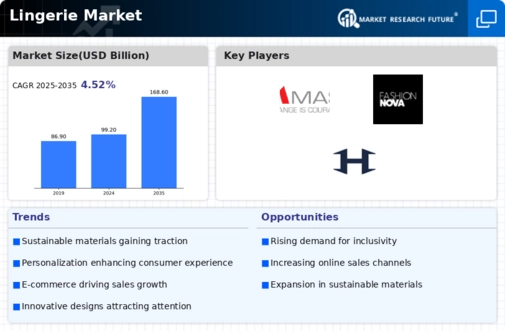Focus on Health and Wellness
The Lingerie Market is increasingly aligning itself with the broader health and wellness trend. Consumers are becoming more health-conscious, seeking lingerie that offers both comfort and support. This has led to a rise in demand for products that promote body positivity and well-being, such as bras with ergonomic designs and materials that provide adequate support without compromising comfort. Market data shows that sales of wellness-oriented lingerie have increased, reflecting a growing awareness of the importance of health in everyday apparel choices. This focus on health and wellness is likely to continue shaping the Lingerie Market in the coming years.
Rise of E-commerce Platforms
The Lingerie Market is significantly benefiting from the rise of e-commerce platforms. With the convenience of online shopping, consumers are increasingly turning to digital channels for their lingerie purchases. Data indicates that online sales in the lingerie sector have grown by approximately 25 percent annually, driven by the proliferation of mobile shopping and social media marketing. This trend allows brands to reach a broader audience and engage with consumers through targeted advertising. Furthermore, the ability to offer personalized shopping experiences online is enhancing customer satisfaction, which is crucial for brand loyalty in the Lingerie Market.
Changing Consumer Preferences
The Lingerie Market is witnessing a shift in consumer preferences, particularly among younger demographics. Millennials and Generation Z are increasingly favoring brands that align with their values, such as sustainability and inclusivity. This shift is reflected in the rising popularity of bralettes and loungewear-inspired lingerie, which prioritize comfort over traditional aesthetics. Market data suggests that the demand for such products has surged, with sales of bralettes increasing by over 30 percent in recent years. This evolution in consumer taste is prompting brands to adapt their offerings, thereby influencing the overall landscape of the Lingerie Market.
Influence of Celebrity Endorsements
The Lingerie Market is notably influenced by celebrity endorsements and collaborations. High-profile figures and influencers are increasingly promoting lingerie brands, which can significantly impact consumer purchasing decisions. This trend is particularly evident on social media platforms, where influencers showcase their favorite lingerie pieces, creating a sense of aspiration among followers. Market analysis suggests that brands leveraging celebrity partnerships experience a notable increase in brand visibility and sales. This dynamic indicates that the Lingerie Market is not only driven by product quality but also by the cultural relevance and desirability created through celebrity influence.
Technological Advancements in Fabrication
The Lingerie Market is experiencing a notable transformation due to advancements in textile technology. Innovations such as moisture-wicking fabrics, seamless construction, and 3D knitting techniques are enhancing comfort and fit. These developments not only improve the wearability of lingerie but also cater to the increasing demand for performance-oriented products. As consumers become more discerning, brands that leverage these technologies are likely to gain a competitive edge. The integration of smart textiles, which can monitor body temperature and provide support, is also emerging. This trend indicates a shift towards functional lingerie that meets the needs of modern consumers, thereby driving growth in the Lingerie Market.



 Source: Secondary Research, Primary Research, Market Research Future Database and Analyst Review
Source: Secondary Research, Primary Research, Market Research Future Database and Analyst Review










Leave a Comment